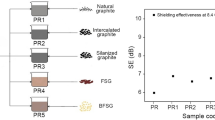Abstract
Carbonyl iron/epoxy coatings are widely used in military as a radar absorbing coating (RAC). The behaviors of RACs under working environments are very important, especially in the new environments such as ozone appeared with widening of the application fields. The effects of ozone degradation on pure epoxy cured with anhydride and the influence of carbonyl Fe on the degradation of epoxy are studied. The results indicate that if the peak at 1,510 cm−1 was used as the inner standard, the intensity of absorption peaks at 1,738, 1,247 and 1,182 cm−1 increases with exposure time for pure epoxy resin, while for the carbonyl iron/epoxy coatings, the three peaks changes insignificantly with the exposure time. The results indicates the oxidation process begins at the hydroxyl and methyl groups, and finally ozonide and carbonyl are formed on the surface for pure epoxy, and epoxy is eroded gradually in depth by ozone. Carbonyl iron could hinder the meeting of ozone with epoxy with dilution or hindrance effect and could protect epoxy resin from ozone and thus delay the deterioration of the coating performance.









Similar content being viewed by others
References
Maksimenko SA, Rodionova VN, Slepyan GYa, Karpovich VA, Shenderova O, Walsh J, Kuznetsov VL, Mazov IN, Moseenkov SI, Okotrub AV, Lambin Ph (2007) Attenuation of electromagnetic waves in onion-like carbon composites. Diam Relat Mater 16:1231–1235
Oh JH, Oh KS, Kim ChG, Hong CS (2004) Design of radar absorbing structures using glass/epoxy composite containing carbon black in X-band frequency ranges. Compos B 35:49–56
Meng XQ (2000) Studying status and developing trend of radar absorbing coatings material. Mod Def Technol 28:47–50
Lee WJ, Lee JW, Kim ChG (2008) Characteristics of an electromagnetic wave absorbing composite structure with a conducting polymer electromagnetic bandgap (EBG) in the X-band. Compos Sci Technol 68:2485–2489
Wang L, Gao H (2004) Summarization of antiradar coatings. Surf Technol 33:13–15
Yuan X, Wang H, Zha B, Hou G, Hou P (2007) Submicron-Fe/polyamide composite absorber coating by low temperature high velocity air fuel spray technique. Surf Coat Technol 201:7130–7137
Feng YB, Qiu T, Shen CY (2007) Absorbing properties and structural design of microwave absorbers based on carbonyl iron and barium ferrite. J Magn Magn Mater 318:8–13
Abbas SM, Dixit AK, Chatterjee R, Goel TC (2007) Complex permittivity, complex permeability and microwave absorption properties of ferrite–polymer composites. J Magn Magn Mater 309:20–24
Oikonomou A, Giannakopoulou T, Litsardakis G (2007) Design, fabrication and characterization of hexagonal ferrite multi-layer microwave absorber. J Magn Magn Mater 316:e827–e830
Mao WM, Fang K, Wuand QY, Feng HP (2005) Conductive polyaniline/iron carbonyl powder composite material for wave absorbing. Acta Mater Compos Sin 22:11–14
Liu JH, Zhou XM, Li SM (2005) Electromagnetic properties of carbonyl iron/polyaniline microtubules. Acta Mater Compos Sin 22:70–74
Kim PCh, Lee DG (2009) Composite sandwich constructions for absorbing the electromagnetic waves. Compos Struct 87:161–167
Cataldo F, Angelini G (2006) Some aspects of the ozone degradation of poly(vinyl alcohol). Polym Degrad Stab 91:2793–2800
Allen NS, Edge M, Mourelatou D, Wilkinson A, Liauw CM, Parellada MD, Barrio JA, Quiteria VRS (2003) Infuence of ozone on styrene–ethylene–butylenes–styrene (SEBS) copolymer. Polym Degrad Stab 79:297–307
Razumovskii SD, Zaikov GYe (1982) Effect of ozone on saturated polymers. Polym Sci USSR 24:2305–2325
Author information
Authors and Affiliations
Corresponding author
Rights and permissions
About this article
Cite this article
Peng, G., Wang, H., Wang, H. et al. Influence of Carbonyl Fe on Degradation of Epoxy in Ozone Environment. J Polym Environ 17, 159–164 (2009). https://doi.org/10.1007/s10924-009-0133-z
Published:
Issue Date:
DOI: https://doi.org/10.1007/s10924-009-0133-z




